load LEXUS UX200 2019 Owner's Guide
[x] Cancel search | Manufacturer: LEXUS, Model Year: 2019, Model line: UX200, Model: LEXUS UX200 2019Pages: 452, PDF Size: 10.06 MB
Page 392 of 452
![LEXUS UX200 2019 Owners Guide 3928-1. Specifications
■Oil capacity (Drain and refill [Ref-
erence*])
*: The engine oil capacity is a reference quantity to be used when changing the
engine oil. Warm up and turn off the
engine, LEXUS UX200 2019 Owners Guide 3928-1. Specifications
■Oil capacity (Drain and refill [Ref-
erence*])
*: The engine oil capacity is a reference quantity to be used when changing the
engine oil. Warm up and turn off the
engine,](/img/36/58038/w960_58038-391.png)
3928-1. Specifications
■Oil capacity (Drain and refill [Ref-
erence*])
*: The engine oil capacity is a reference quantity to be used when changing the
engine oil. Warm up and turn off the
engine, wait more than 5 minutes, and
check the oil level on the dipstick.
■Engine oil selection
“Toyota Genuine Motor Oil” is used in
your Lexus vehicle. Use Lexus
approved “Toyota Genuine Motor Oil”
or equivalent to satisfy the following
grade and viscosity.
Oil grade: API SN/RC multigrade
engine oil
Recommended viscosity: SAE 0W-16
SAE 0W-16 is the best choice for good
fuel economy and good starting in cold
weather.
If SAE 0W-16 is not available, SAE
0W-20 oil may be used. However, it
must be replaced with SAE 0W-16 at
the next oil change.
Outside temperature Oil viscosity (0W-16 is explained here
as an example):
• The 0W in 0W-16 indicates the
characteristic of the oil which allows
cold startability. Oils with a lower
value before the W allow for easier
starting of the engine in cold
weather.
• The 16 in 0W-16 indicates the vis- cosity characteristic of the oil when
the oil is at high temperature. An oil
with a higher viscosity (one with a
higher value) may be better suited if
the vehicle is operated at high
speeds, or under extreme load con-
ditions.
How to read oil container label:
API registered marks is added to some
oil containers to help you select the oil
you should use.
Lubrication system
With filter4.9 qt. (4.6 L, 4.0 Imp.qt.)
Without filter4.5 qt. (4.3 L, 3.8 Imp.qt.)
A
Page 399 of 452
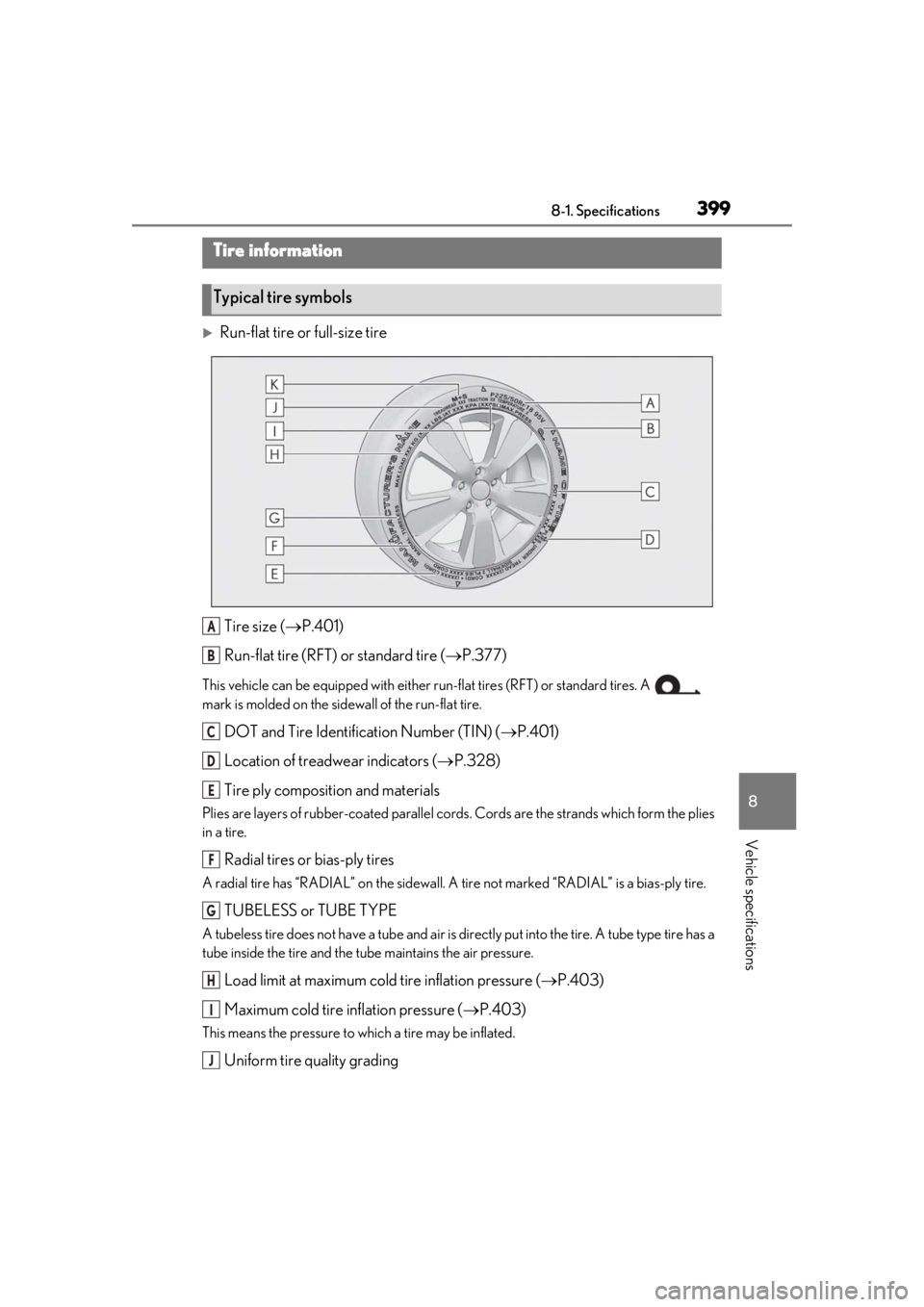
3998-1. Specifications
8
Vehicle specifications
Run-flat tire or full-size tireTire size ( P.401)
Run-flat tire (RFT) or standard tire ( P.377)
This vehicle can be equipped with either run-flat tires (RFT) or standard tires. A
mark is molded on the sidewall of the run-flat tire.
DOT and Tire Identification Number (TIN) ( P.401)
Location of treadwear indicators ( P.328)
Tire ply composition and materials
Plies are layers of rubber-coated parallel cords. Cords are the strands which form the plies
in a tire.
Radial tires or bias-ply tires
A radial tire has “RADIAL” on the sidewall. A tire not marked “RADIAL” is a bias-ply tire.
TUBELESS or TUBE TYPE
A tubeless tire does not have a tube and air is directly put into the tire. A tube type tire has a
tube inside the tire and the tube maintains the air pressure.
Load limit at maximum cold tire inflation pressure ( P.403)
Maximum cold tire inflation pressure ( P.403)
This means the pressure to which a tire may be inflated.
Uniform tire quality grading
Tire information
Typical tire symbols
A
B
C
D
E
F
G
H
I
J
Page 400 of 452
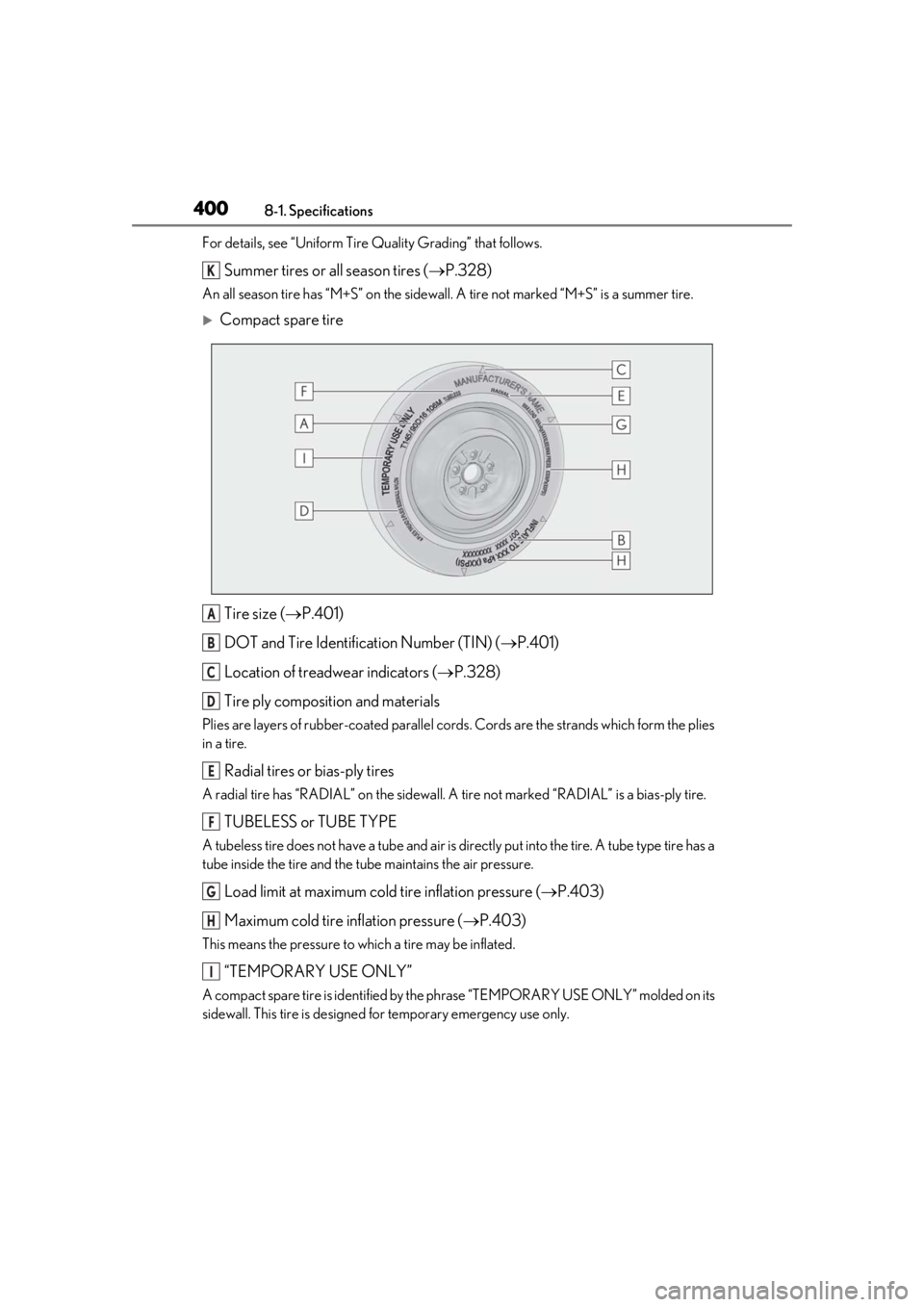
4008-1. Specifications
For details, see “Uniform Tire Quality Grading” that follows.
Summer tires or all season tires (P.328)
An all season tire has “M+S” on the sidewall. A tire not marked “M+S” is a summer tire.
Compact spare tire
Tire size ( P.401)
DOT and Tire Identification Number (TIN) ( P.401)
Location of treadwear indicators ( P.328)
Tire ply composition and materials
Plies are layers of rubber-coated parallel cords. Cords are the strands which form the plies
in a tire.
Radial tires or bias-ply tires
A radial tire has “RADIAL” on the sidewall. A tire not marked “RADIAL” is a bias-ply tire.
TUBELESS or TUBE TYPE
A tubeless tire does not have a tube and air is directly put into the tire. A tube type tire has a
tube inside the tire and the tube maintains the air pressure.
Load limit at maximum cold tire inflation pressure ( P.403)
Maximum cold tire inflation pressure ( P.403)
This means the pressure to which a tire may be inflated.
“TEMPORARY USE ONLY”
A compact spare tire is identified by the phrase “TEMPORARY USE ONLY” molded on its
sidewall. This tire is designed for temporary emergency use only.
K
A
B
C
D
E
F
G
H
I
Page 401 of 452
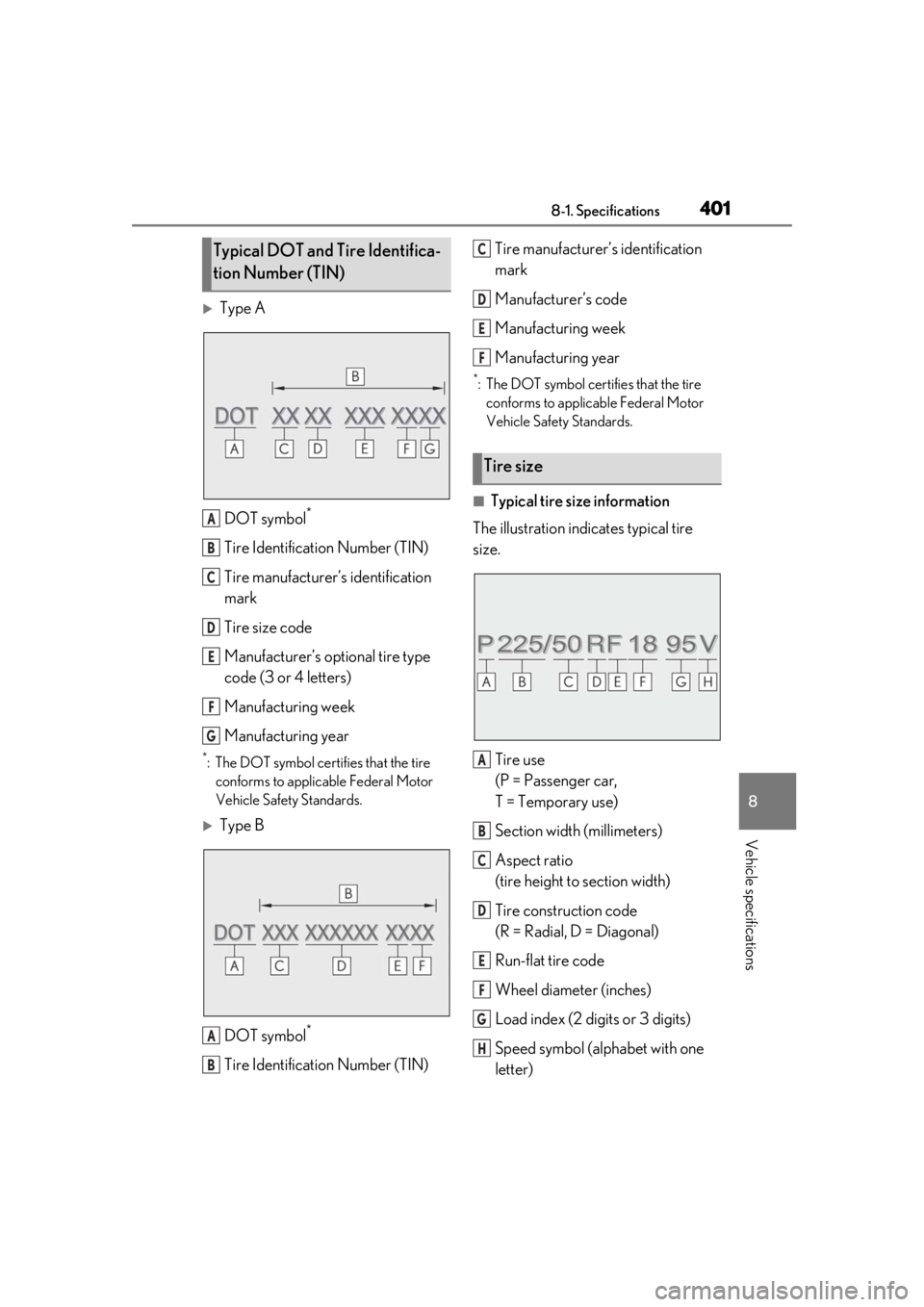
4018-1. Specifications
8
Vehicle specifications
Type ADOT symbol
*
Tire Identification Number (TIN)
Tire manufacturer’s identification
mark
Tire size code
Manufacturer’s optional tire type
code (3 or 4 letters)
Manufacturing week
Manufacturing year
*:The DOT symbol cert ifies that the tire
conforms to applicable Federal Motor
Vehicle Safety Standards.
Type B
DOT symbol
*
Tire Identification Number (TIN) Tire manufacturer’s identification
mark
Manufacturer’s code
Manufacturing week
Manufacturing year
*: The DOT symbol certifies that the tire
conforms to applicable Federal Motor
Vehicle Safety Standards.
■Typical tire size information
The illustration indicates typical tire
size.
Tire use
(P = Passenger car,
T = Temporary use)
Section width (millimeters)
Aspect ratio
(tire height to section width)
Tire construction code
(R = Radial, D = Diagonal)
Run-flat tire code
Wheel diameter (inches)
Load index (2 digits or 3 digits)
Speed symbol (alphabet with one
letter)
Typical DOT and Tire Identifica-
tion Number (TIN)
A
B
C
D
E
F
G
A
B
Tire size
C
D
E
F
A
B
C
D
E
F
G
H
Page 403 of 452
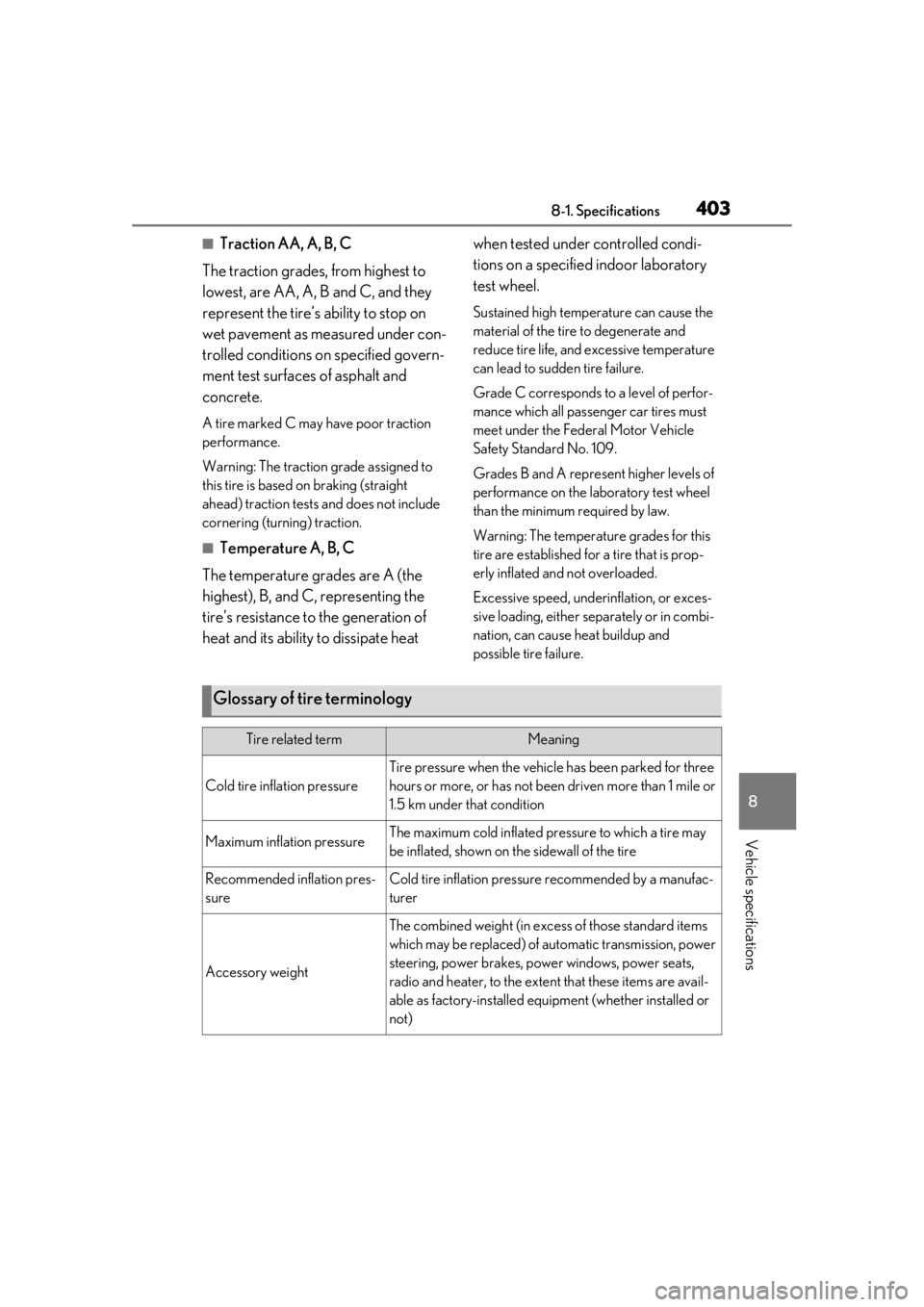
4038-1. Specifications
8
Vehicle specifications
■Traction AA, A, B, C
The traction grades, from highest to
lowest, are AA, A, B and C, and they
represent the tire’s ability to stop on
wet pavement as measured under con-
trolled conditions on specified govern-
ment test surfaces of asphalt and
concrete.
A tire marked C may have poor traction
performance.
Warning: The traction grade assigned to
this tire is based on braking (straight
ahead) traction tests and does not include
cornering (turning) traction.
■Temperature A, B, C
The temperature grades are A (the
highest), B, and C, representing the
tire’s resistance to the generation of
heat and its ability to dissipate heat when tested under controlled condi-
tions on a specified indoor laboratory
test wheel.
Sustained high temperature can cause the
material of the tire to degenerate and
reduce tire life, and excessive temperature
can lead to sudd
en tire failure.
Grade C corresponds to a level of perfor-
mance which all passenger car tires must
meet under the Fede ral Motor Vehicle
Safety Standard No. 109.
Grades B and A represent higher levels of
performance on the laboratory test wheel
than the minimum required by law.
Warning: The temperature grades for this
tire are established for a tire that is prop-
erly inflated and not overloaded.
Excessive speed, unde rinflation, or exces-
sive loading, either separately or in combi-
nation, can cause heat buildup and
possible tire failure.
Glossary of tire terminology
Tire related termMeaning
Cold tire inflation pressure
Tire pressure when the vehicle has been parked for three
hours or more, or has not been driven more than 1 mile or
1.5 km under that condition
Maximum inflation pressureThe maximum cold inflated pressure to which a tire may
be inflated, shown on the sidewall of the tire
Recommended inflation pres-
sureCold tire inflation pressure recommended by a manufac-
turer
Accessory weight
The combined weight (in excess of those standard items
which may be replaced) of automatic transmission, power
steering, power brakes, powe r windows, power seats,
radio and heater, to the extent that these items are avail-
able as factory-installed equi pment (whether installed or
not)
Page 404 of 452
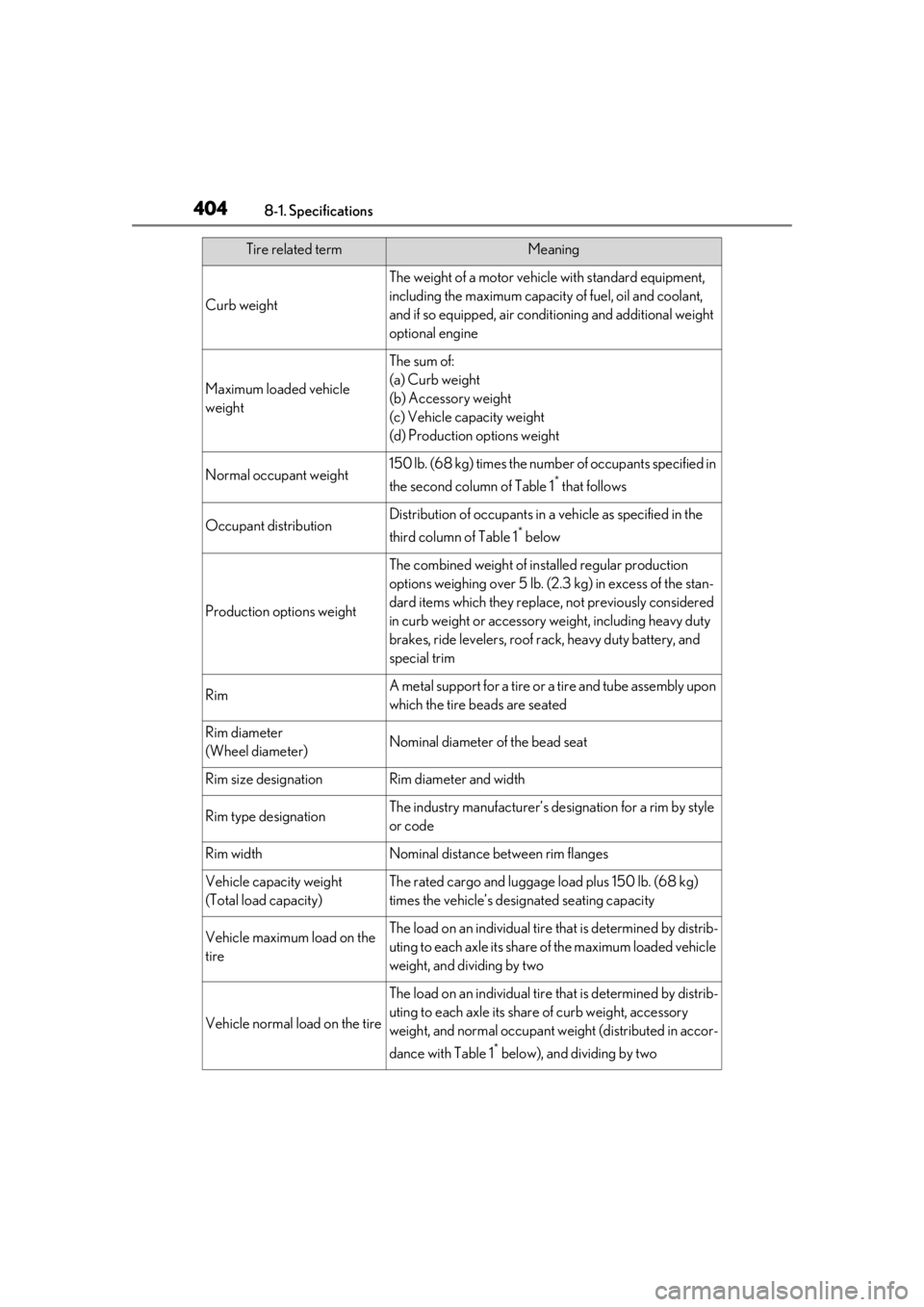
4048-1. Specifications
Curb weight
The weight of a motor vehicle with standard equipment,
including the maximum capacity of fuel, oil and coolant,
and if so equipped, air conditioning and additional weight
optional engine
Maximum loaded vehicle
weight
The sum of:
(a) Curb weight
(b) Accessory weight
(c) Vehicle capacity weight
(d) Production options weight
Normal occupant weight150 lb. (68 kg) times the number of occupants specified in
the second column of Table 1
* that follows
Occupant distributionDistribution of occupants in a vehicle as specified in the
third column of Table 1
* below
Production options weight
The combined weight of in stalled regular production
options weighing over 5 lb. (2.3 kg) in excess of the stan-
dard items which they replace, not previously considered
in curb weight or accessory weight, including heavy duty
brakes, ride levelers, roof rack, heavy duty battery, and
special trim
RimA metal support for a tire or a tire and tube assembly upon
which the tire beads are seated
Rim diameter
(Wheel diameter)Nominal diameter of the bead seat
Rim size designationRim diameter and width
Rim type designationThe industry manufacturer’s designation for a rim by style
or code
Rim widthNominal distance between rim flanges
Vehicle capacity weight
(Total load capacity)The rated cargo and luggage load plus 150 lb. (68 kg)
times the vehicle’s desi gnated seating capacity
Vehicle maximum load on the
tireThe load on an individual tire that is determined by distrib-
uting to each axle its share of the maximum loaded vehicle
weight, and dividing by two
Vehicle normal load on the tire
The load on an individual tire that is determined by distrib-
uting to each axle its shar e of curb weight, accessory
weight, and normal occupant we ight (distributed in accor-
dance with Table 1
* below), and dividing by two
Tire related termMeaning
Page 405 of 452

4058-1. Specifications
8
Vehicle specifications
Weather sideThe surface area of the rim not covered by the inflated tire
BeadThe part of the tire that is made of steel wires, wrapped or
reinforced by ply cords and th at is shaped to fit the rim
Bead separationA breakdown of the bond between components in the
bead
Bias ply tire
A pneumatic tire in which the ply cords that extend to the
beads are laid at alternate angles substantially less than
90 degrees to the centerline of the tread
CarcassThe tire structure, except tread and sidewall rubber which,
when inflated, bears the load
ChunkingThe breaking away of pieces of the tread or sidewall
CordThe strands forming the plies in the tire
Cord separationThe parting of cords from adjacent rubber compounds
CrackingAny parting within the tread, si dewall, or innerliner of the
tire extending to cord material
CT
A pneumatic tire with an inverted flange tire and rim sys-
tem in which the rim is designed with rim flanges pointed
radially inward and the tire is designed to fit on the under-
side of the rim in a manner that encloses the rim flanges
inside the air cavity of the tire
Extra load tireA tire designed to operate at higher loads and at higher
inflation pressures than the corresponding standard tire
GrooveThe space between two adjacent tread ribs
InnerlinerThe layer(s) forming the inside surface of a tubeless tire
that contains the inflating medium within the tire
Innerliner separationThe parting of the innerliner fr om cord material in the car-
cass
Intended outboard sidewall
(a)The sidewall that contains a whitewall, bears white let-
tering, or bears manufacturer, brand, and/or model name
molding that is higher or de eper than the same molding
on the other sidewall of the tire, or
(b)The outward facing sidewall of an asymmetrical tire
that has a particular side that must always face outward
when mounted on a vehicle
Tire related termMeaning
Page 406 of 452
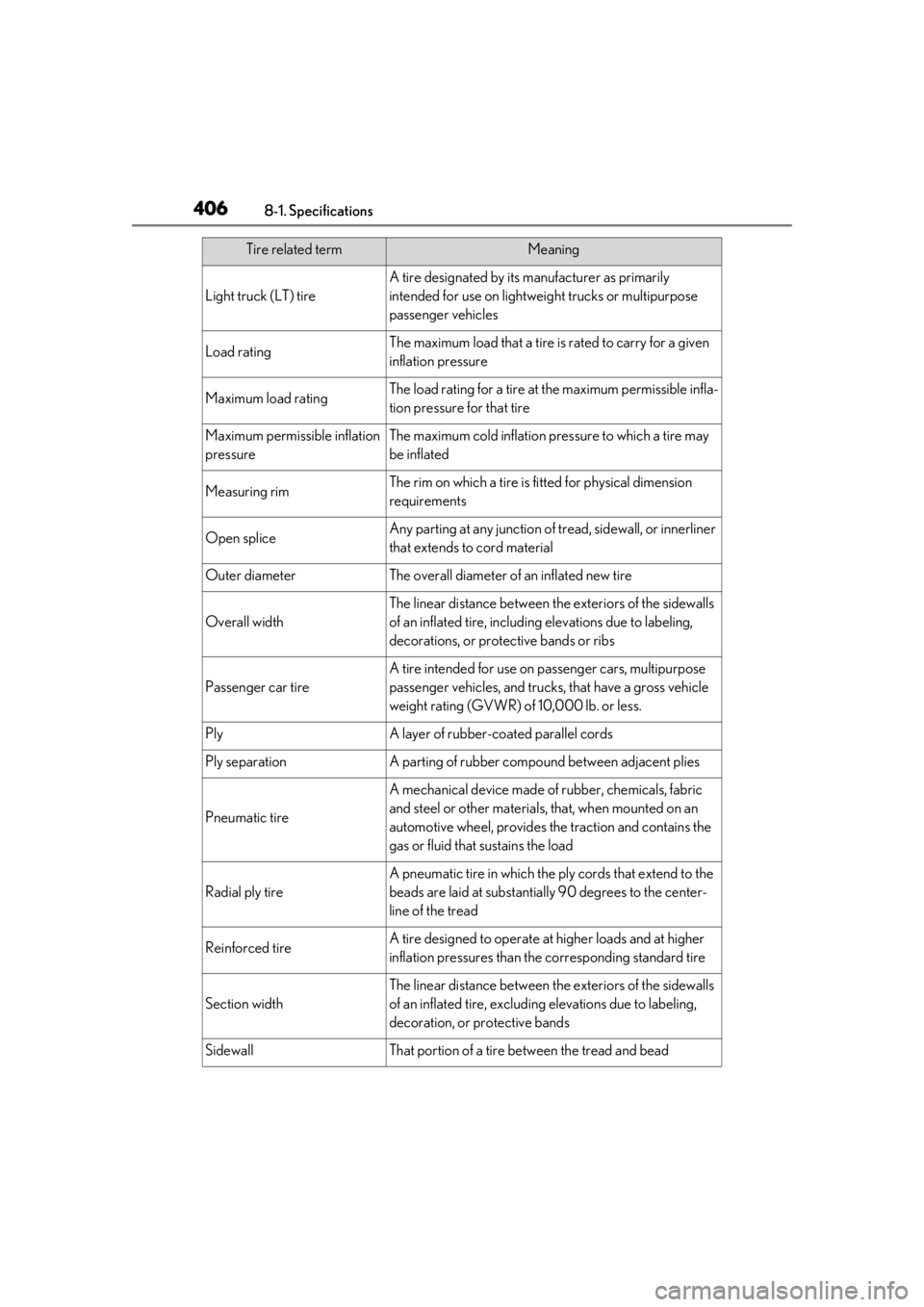
4068-1. Specifications
Light truck (LT) tire
A tire designated by its manufacturer as primarily
intended for use on lightweight trucks or multipurpose
passenger vehicles
Load ratingThe maximum load that a tire is rated to carry for a given
inflation pressure
Maximum load ratingThe load rating for a tire at the maximum permissible infla-
tion pressure for that tire
Maximum permissible inflation
pressureThe maximum cold inflation pressure to which a tire may
be inflated
Measuring rimThe rim on which a tire is fi tted for physical dimension
requirements
Open spliceAny parting at any junction of tread, sidewall, or innerliner
that extends to cord material
Outer diameterThe overall diameter of an inflated new tire
Overall width
The linear distance between the exteriors of the sidewalls
of an inflated tire, including elevations due to labeling,
decorations, or protective bands or ribs
Passenger car tire
A tire intended for use on passenger cars, multipurpose
passenger vehicles, and trucks, that have a gross vehicle
weight rating (GVWR) of 10,000 lb. or less.
PlyA layer of rubber-coated parallel cords
Ply separationA parting of rubber compou nd between adjacent plies
Pneumatic tire
A mechanical device made of rubber, chemicals, fabric
and steel or other materials, that, when mounted on an
automotive wheel, provides the traction and contains the
gas or fluid that sustains the load
Radial ply tire
A pneumatic tire in which the ply cords that extend to the
beads are laid at substantially 90 degrees to the center-
line of the tread
Reinforced tireA tire designed to operate at higher loads and at higher
inflation pressures than the corresponding standard tire
Section width
The linear distance between the exteriors of the sidewalls
of an inflated tire, excludin g elevations due to labeling,
decoration, or protective bands
SidewallThat portion of a tire between the tread and bead
Tire related termMeaning
Page 407 of 452
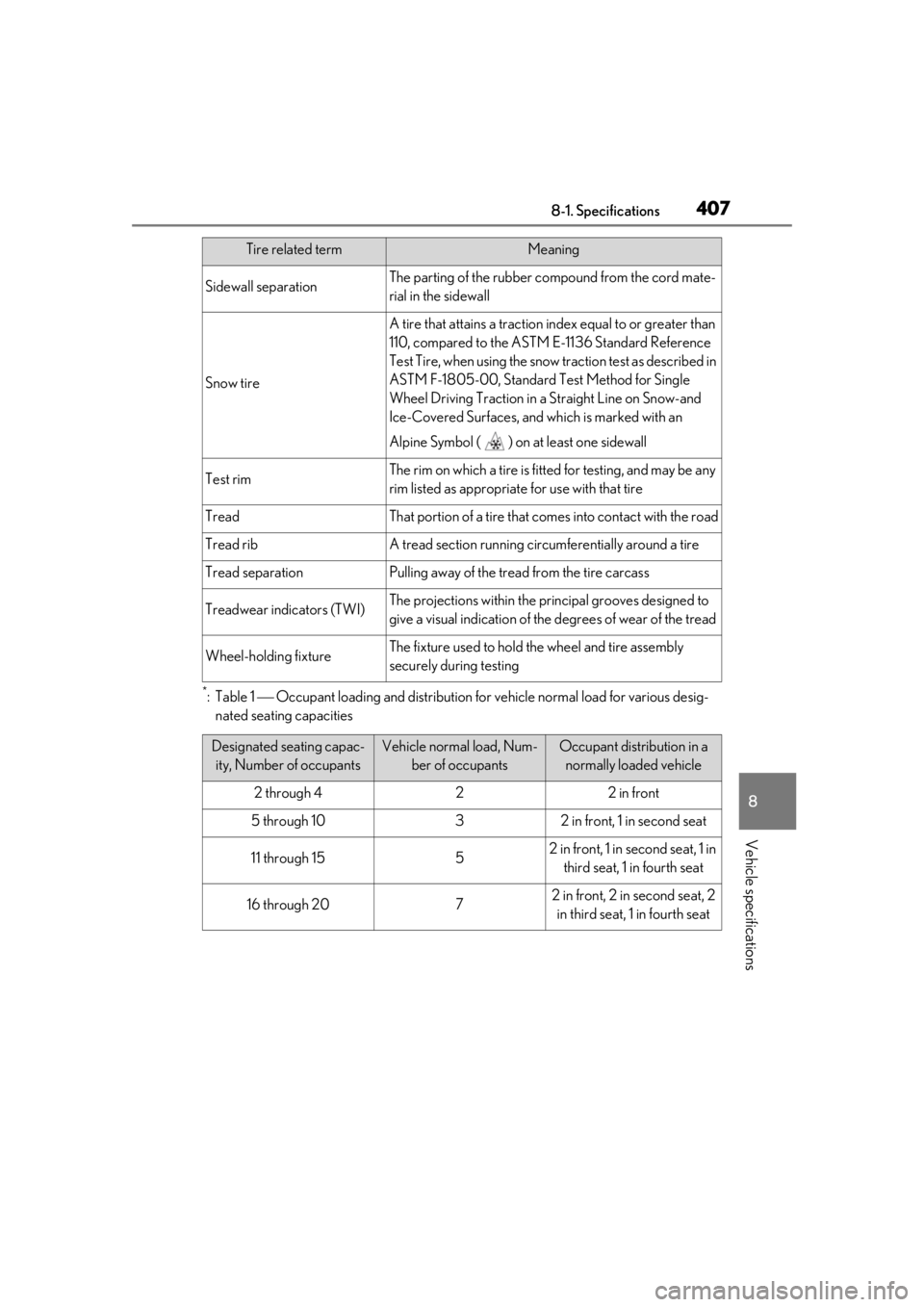
4078-1. Specifications
8
Vehicle specifications
*:Table 1 Occupant loading and distribution for vehicle normal load for various desig-
nated seating capacities
Sidewall separationThe parting of the rubber co mpound from the cord mate-
rial in the sidewall
Snow tire
A tire that attains a traction index equal to or greater than
110, compared to the ASTM E-1136 Standard Reference
Test Tire, when using the snow traction test as described in
ASTM F-1805-00, Standard Test Method for Single
Wheel Driving Traction in a Straight Line on Snow-and
Ice-Covered Surfaces, and wh ich is marked with an
Alpine Symbol ( ) on at least one sidewall
Test rimThe rim on which a tire is fitt ed for testing, and may be any
rim listed as appropriate for use with that tire
TreadThat portion of a tire that comes into contact with the road
Tread ribA tread section running circ umferentially around a tire
Tread separationPulling away of the tread from the tire carcass
Treadwear indicators (TWI)The projections within the pr incipal grooves designed to
give a visual indication of th e degrees of wear of the tread
Wheel-holding fixtureThe fixture used to hold the wheel and tire assembly
securely during testing
Designated seating capac-
ity, Number of occupantsVehicle normal load, Num- ber of occupantsOccupant distribution in a normally loaded vehicle
2 through 422 in front
5 through 1032 in front, 1 in second seat
11 through 1552 in front, 1 in second seat, 1 in third seat, 1 in fourth seat
16 through 2072 in front, 2 in second seat, 2 in third seat, 1 in fourth seat
Tire related termMeaning
Page 446 of 452

446Alphabetical Index
Garage door opener switches .......... 295
Head-up display switch............................. 87
Heated steering wheel.............................. 271
Ignition switch................................................152
Instrument panel light control switches....................................................................74, 78
Intuitive parking assist switch................. 221
Light switch .................................................... 165
LTA (Lane-Tracing Assist) switch ..... 198
Meter control switches ................................81
Moon roof switches ................................... 137
Outside rear view mi rror switches ..... 132
Paddle shift switches ....................... 157, 158
Parking brake switch ................................ 160
PCS OFF switch ......................................... 188
PKSB (Parking Support Brake) switch ......................................................................... 232
Power back door opener and closer switch............................................................. 105
Power door lock switch .......................... 100
Power window switch ...............................135
RCTA switch.................................................227
Rear window and outside rear view mir- ror defoggers switch ............................ 263
Rear window wiper and washer switch ........................................................................... 176
Seat heater switches .................................272
Seat ventilator switches ...........................272
Tire pressure warning reset switch .. 333
Vehicle-to-vehicle distance switch ..205
VSC off switch ............................................ 245
Window lock switch ..................................136
Windshield wiper de-icer switch ...... 266
Windshield wipers and washer switch ........................................................................... 172
T
Tachometer................................................72, 75 Rev indicator .................................................... 77
Rev peak ............................................................ 77
Tail lights Light switch .................................................... 165 Replacing light bulbs ................................346
Theft deterrent system Alarm................................................................... 64
Engine immobilizer system...................... 62
Tire inflation pressure Maintenance data ..................................... 395
Tire inflation pressure display function......................................................................... 330
Warning light .............................................. 359
Tire information ............................................ 399 Glossary ........................................................ 403
Size ..................................................................... 401
Tire identification number....................... 401
Uniform Tire Quality Grading ............402
Tire pressure warning system Function ......................................................... 330
Initializing........................................................333
Installing tire pres sure warning valves
and transmitters....................................... 332
Registering ID codes ...............................335
Warning light .............................................. 359
Tires................................................................... 328 Chains .............................................................. 251
Checking .......................................................328
If you have a flat tire ...................... 370, 377
Inflation pressure ........................... 337, 395
Replacing .......................................................370
Rotating tires ............................................... 330
Run-flat tires......................................330, 377
Size ................................................................... 395
Snow tires ...................................................... 249
Spare tire ........................................................370
Tire pressure warning system ............ 330
Warning light .............................................. 359
Tools........................................................ 280, 371
Top tether strap............................................... 54
Total load capacity ...................................... 390
Towing Dinghy towing ................................................ 151
Emergency towing....................................353
Towing eyelet.............................................. 280
Trailer towing ................................................ 150